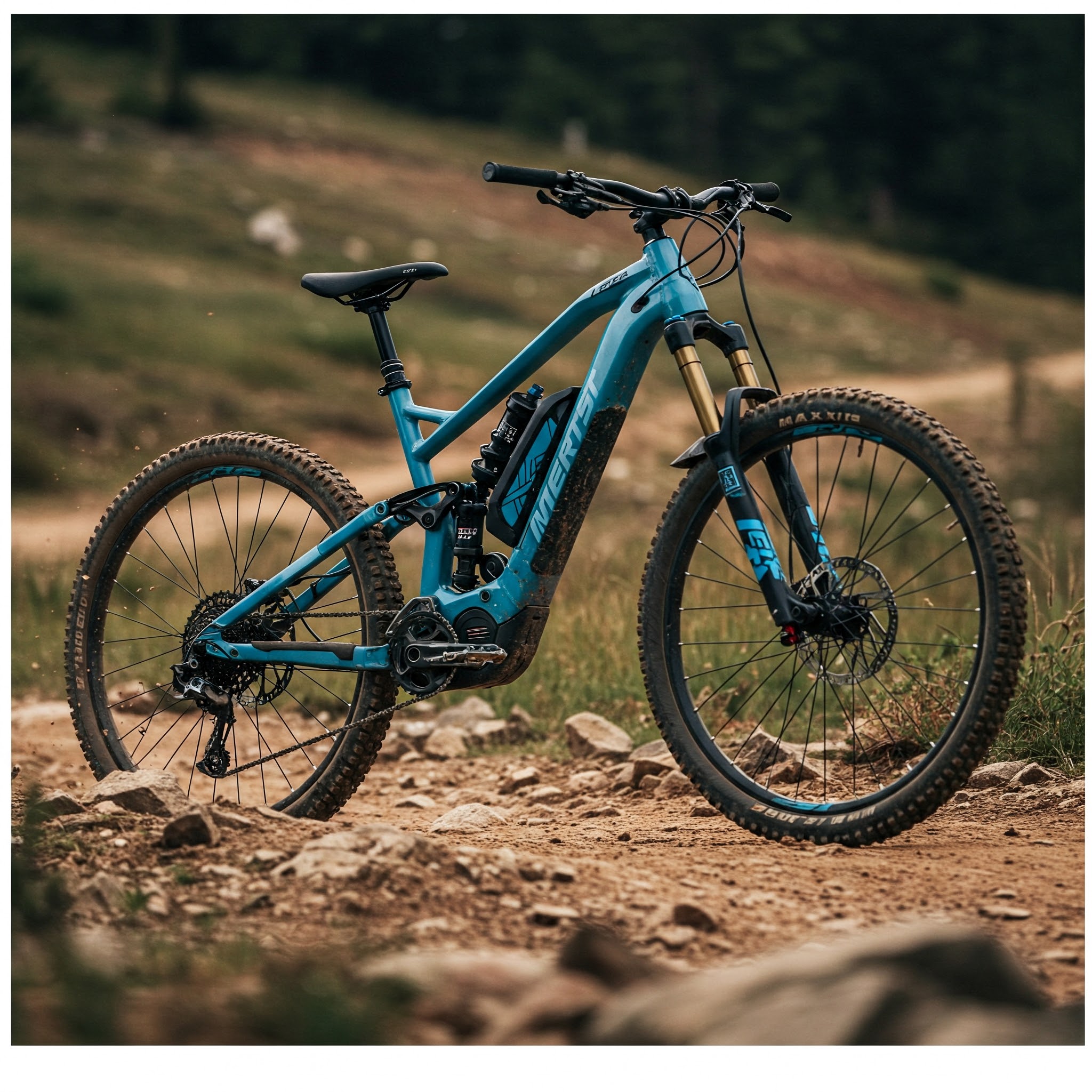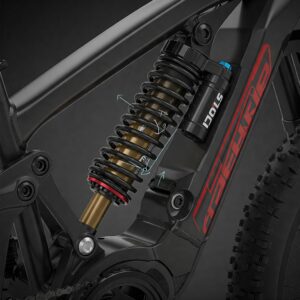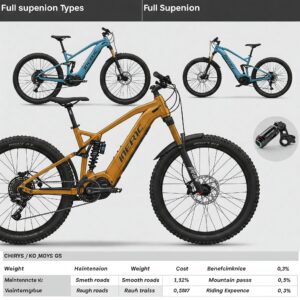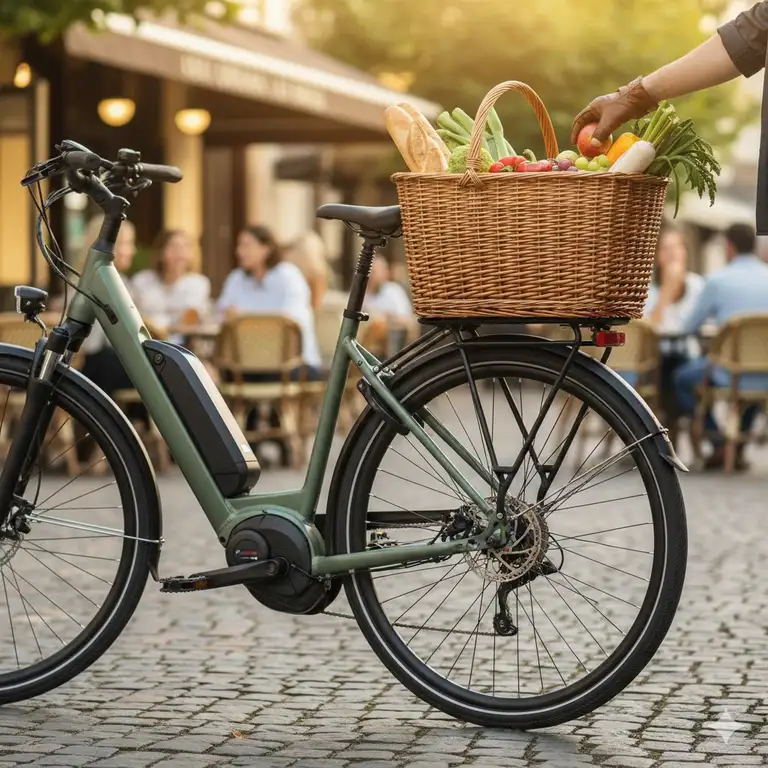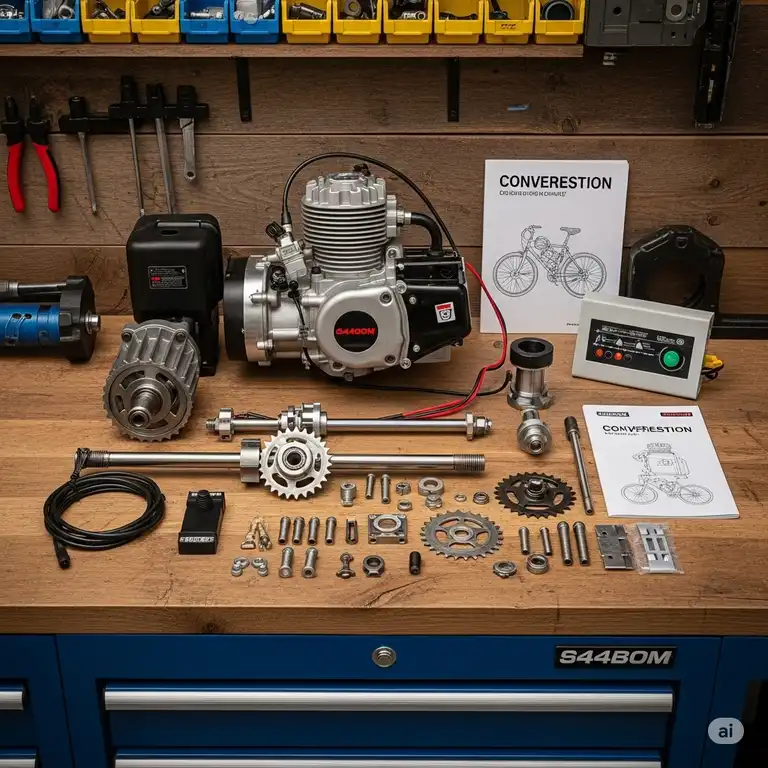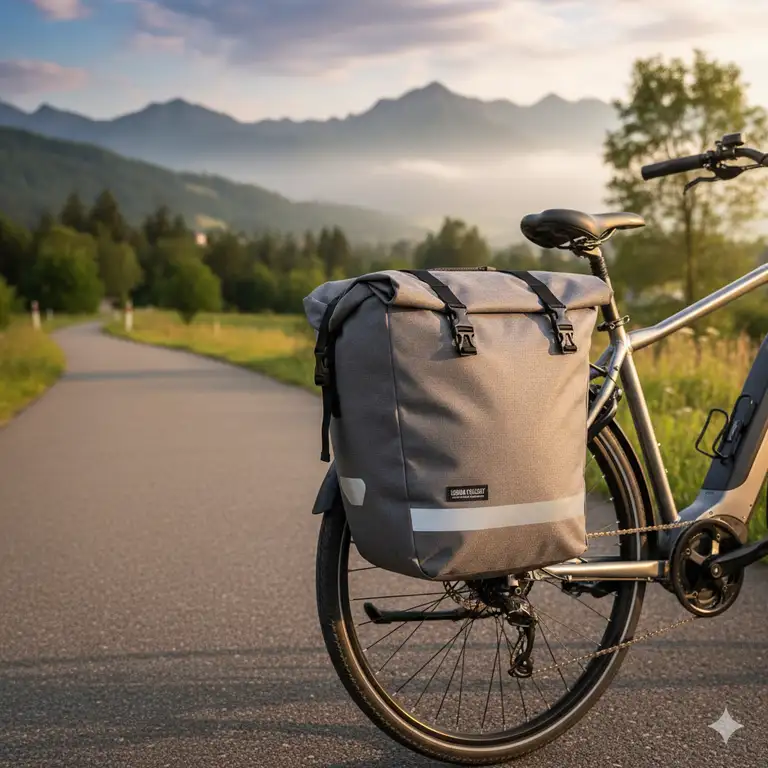Are you tired of feeling every bump and pothole during your e bike adventures? A quality e bike suspension system can transform your riding experience from jarring and uncomfortable to smooth and enjoyable. Whether you’re navigating urban streets with unexpected obstacles or hitting off-road trails, understanding e bike suspension technology is essential for maximizing your comfort, control, and overall riding pleasure.
✨Was this helpful? Spread the word! 🚀
E bike suspension systems have evolved significantly in recent years, with manufacturers developing specialized components designed specifically for the unique demands of electric bicycles. The added weight, speed capabilities, and riding characteristics of e bikes require suspension solutions that differ from traditional bicycle setups.
In this comprehensive guide, we’ll explore everything you need to know about e bike suspension, from the basic principles to advanced setup techniques. We’ll also recommend some of the best e bike suspension components currently available on the market to help you make informed decisions about upgrading your riding experience.
Understanding E Bike Suspension: Basics and Benefits
E bike suspension refers to the system of components that absorb shocks and vibrations when riding over uneven terrain. Unlike traditional bicycles, e bikes typically weigh more due to their motors and batteries, making effective suspension even more critical for maintaining control and comfort.
There are several key benefits to having quality suspension on your e bike:
✅ Enhanced Comfort: Reduces fatigue during longer rides by absorbing impacts
✅ Improved Control: Keeps wheels in contact with the ground for better handling
✅ Increased Safety: Provides more predictable behavior on rough surfaces
✅ Better Traction: Maintains tire contact with the ground on uneven terrain
✅ Protected Components: Reduces stress on the frame, wheels, and other bike parts
✅ Extended Range: Less energy wasted on fighting terrain means more efficient battery use
Comparing E Bike Suspension with Traditional Bicycle Suspension
| Feature | E Bike Suspension | Traditional Bicycle Suspension |
|---|---|---|
| Weight Capacity | Higher (accommodates bike + motor + battery) | Lower (designed for human weight only) |
| Stiffness | Generally stiffer to handle increased forces | Typically more compliant |
| Travel | Often shorter to maintain efficiency | Can vary widely based on discipline |
| Damping | Usually more sophisticated to handle higher speeds | Ranges from basic to advanced |
| Price | Typically higher due to reinforced components | Wider range from budget to premium |
| Adjustability | Often includes e-bike specific settings | Standard adjustment options |
| Integration | May feature motor/battery integration | No electrical integration |
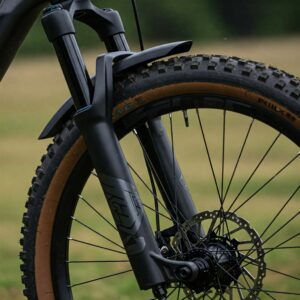
Types of E Bike Suspension Systems
There are three main types of suspension systems for e bikes, each offering different levels of performance and comfort:
1. Front Suspension (Hardtail)
Front suspension e bikes, often called “hardtails,” feature suspension forks at the front wheel while maintaining a rigid rear frame. This is the most common type of suspension found on entry to mid-level e bikes.
Benefits of front suspension e bikes:
- More affordable than full-suspension options
- Lighter weight and more efficient on smooth terrain
- Less maintenance required
- Better power transfer when pedaling (less energy loss)
Best suited for:
- Urban commuting with occasional rough patches
- Light trail riding on moderately smooth surfaces
- Riders on a budget seeking some comfort improvement
2. Full Suspension
Full suspension e bikes feature both front forks and rear shock absorbers, providing maximum comfort and control on rough terrain. These systems allow both wheels to track the ground independently, resulting in superior traction and shock absorption.
Benefits of full suspension e bikes:
- Maximum comfort on rough terrain
- Superior traction in technical conditions
- Better control at higher speeds
- Reduced rider fatigue on longer adventures
Best suited for:
- Mountain biking on technical trails
- Off-road adventures on rough terrain
- Riders prioritizing comfort over weight/efficiency
- Those with back or joint issues requiring maximum comfort
3. Suspension Seatposts
For e bikes that don’t have built-in suspension systems, suspension seatposts offer a simple upgrade that can significantly improve comfort. These replace your standard seatpost with one that includes a shock-absorbing mechanism.
Benefits of suspension seatposts:
- Affordable upgrade for rigid e bikes
- Easy to install without major modifications
- Reduces impact on the rider’s body while seated
- Minimal weight addition compared to full suspension
Best suited for:
- Upgrading a rigid e bike on a budget
- Urban commuters seeking more comfort
- Riders who mainly stay seated during rides
- Those with back pain or discomfort from road vibrations
Key Components of E Bike Suspension Systems
Understanding the different components that make up e bike suspension systems will help you make informed decisions when choosing or upgrading your setup.
Front Suspension Forks
The fork is the front suspension component that connects the front wheel to the handlebars. E bike specific forks are designed to handle the additional weight and forces generated by electric motors.
Key features to consider in e bike suspension forks:
✅ Travel: Typically ranging from 80mm to 200mm, this measures how much the fork can compress. Urban e bikes usually have 80-120mm, while e mountain bikes may have 140-200mm for rougher terrain.
✅ Stanchion Diameter: Larger diameter stanchions (the upper tubes) provide more stiffness and durability, which is particularly important for e bikes. Common sizes include 32mm, 34mm, 35mm, and 36mm.
✅ Spring Type:
- Air Springs: Lighter, highly adjustable, and preferred for most modern e bikes
- Coil Springs: More linear feel, lower maintenance, and often more durable
✅ Damping: Controls the speed at which the fork compresses and rebounds. More sophisticated damping systems offer adjustments for:
- Compression (how quickly the fork compresses under impact)
- Rebound (how quickly it returns to full extension)
- Lockout (ability to temporarily disable suspension for efficient climbing or pavement riding)
Rear Suspension Systems
For full-suspension e bikes, the rear suspension system consists of a shock absorber and the frame’s linkage design. There are several common rear suspension designs:
- Single Pivot: Simple design with one main pivot point
- Four-Bar Linkage: Uses four pivot points for improved performance
- Virtual Pivot Point (VPP): Complex design that separates pedaling forces from suspension movement
- Horst Link: Features a pivot on the chainstay for active suspension
Key features in rear shocks:
✅ Stroke Length: The amount the shock can compress, typically 40-75mm
✅ Eye-to-Eye Length: Total length of the shock when fully extended
✅ Spring Type: Air or coil, similar to forks
✅ Damping Adjustments: Similar to forks with compression and rebound settings
✅ Lockout: Some shocks include remote lockout options for efficiency on smooth terrain
Suspension Seatposts
For those looking to add some comfort to an otherwise rigid e bike, suspension seatposts offer 20-40mm of travel that can take the edge off bumpy terrain.
Types of suspension seatposts:
- Parallelogram: Movement follows a parallelogram path to maintain saddle position
- Telescopic: Similar to a small shock absorber
- Elastomer: Uses rubber-like material to absorb impacts
- Air/Oil: More sophisticated systems with adjustable pressure
E Bike Suspension Setup and Adjustment
Proper setup of your e bike suspension is crucial for optimal performance and comfort. The added weight of e bike components means that standard suspension setup guidelines often need modification.
Setting Sag
Sag refers to how much your suspension compresses under your weight when in riding position. Proper sag ensures your suspension works effectively both for absorbing bumps and maintaining traction.
Typical sag recommendations for e bikes:
- Front suspension: 15-20% of total travel for XC/trail, 20-30% for aggressive riding
- Rear suspension: 25-30% of total travel for most applications
How to set sag on your e bike:
- Wear your normal riding gear
- Include any bags or equipment you typically carry
- Position the bike against a wall or have someone hold it
- Mount the bike in your natural riding position
- Measure the initial suspension position
- Carefully dismount without bouncing
- Measure how much the suspension extended
- Calculate the percentage of total travel
- Adjust air pressure or spring preload accordingly
Rebound Adjustment
Rebound controls how quickly your suspension returns to full extension after compression. With the additional weight of e bike systems, proper rebound settings are crucial.
Guidelines for e bike rebound settings:
- Start in the middle of the adjustment range
- Test by riding off a curb while seated
- If the bike feels bouncy or unstable, increase rebound damping (slower)
- If the suspension feels harsh on multiple impacts, decrease rebound damping (faster)
- Aim for a controlled return without excessive bounce
Compression Adjustment
Compression damping controls how quickly your suspension compresses under impact. Many quality e bike suspension components offer separate adjustments for:
- Low-Speed Compression: Affects suspension during body movements, pedaling, and gradual terrain changes
- High-Speed Compression: Controls response to sudden impacts like rocks, roots, and drops
E bike compression settings generally need to be:
- Firmer than traditional bikes to handle the additional weight
- Adjusted based on motor power and rider style
- Fine-tuned for the specific terrain you most frequently ride
Comparing Different E Bike Suspension Models
When selecting an e bike suspension system, it’s important to compare the various options available. Here’s a detailed comparison of some popular models:
| Feature | Entry-Level Models | Mid-Range Models | Premium Models |
|---|---|---|---|
| Price Range | $300-600 | $600-1,200 | $1,200+ |
| Weight | 2.2-2.5kg | 1.8-2.2kg | 1.5-1.8kg |
| Materials | Steel/aluminum mix | Primarily aluminum | Aluminum/carbon |
| Travel | 80-120mm | 120-160mm | 140-200mm |
| Adjustments | Basic rebound | Rebound, compression | Full range of adjustments |
| E-bike Specific | Limited | Moderate | Comprehensive |
| Stanchion Size | 32-34mm | 34-36mm | 35-38mm |
| Service Intervals | 50-100 hours | 100-200 hours | 150-200 hours |
| Damping Technology | Basic | Advanced | Cutting-edge |
| Remote Features | None | Some models | Comprehensive |
💬 Just one click – help others make better buying decisions too!😊
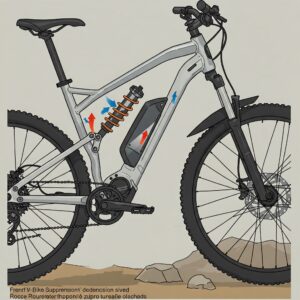
Top E Bike Suspension Components for 2025
Based on performance, durability, and value, here are our top recommendations for e bike suspension components currently available on Amazon:
Front Suspension Forks for E Bikes
1. RockShox Recon Silver RL
The RockShox Recon Silver RL is an excellent mid-range fork specifically designed to handle the additional weight and forces of e bikes. With 120mm of travel, air spring technology, and a lockout feature, this fork offers exceptional value for urban and light trail riders.
Key features:
- E-bike certified construction
- 32mm stanchions with sturdy lower legs
- Solo Air spring for easy setup
- Motion Control damper with lockout
- Available for 27.5″ and 29″ wheels
- Maximum tire clearance of 2.8″
2. FOX 34 E-Bike Factory Series
For serious e mountain bike enthusiasts, the FOX 34 E-Bike Factory series represents the gold standard. This premium fork features FOX’s advanced GRIP2 damper, 34mm stanchions, and is specifically tuned for the extra weight and torque of e bikes.
Key features:
- Kashima coated stanchions for reduced friction
- 140mm travel (adjustable internally)
- High/low-speed compression and rebound adjustment
- E-bike specific damper tuning
- Exceptional small bump sensitivity
- Factory level build quality and support
3. SR Suntour Aion35 Boost EVO
The SR Suntour Aion35 Boost EVO offers excellent performance at a mid-range price point. Specifically designed with e bikes in mind, this fork features 35mm stanchions, adjustable air spring, and a sophisticated damping system.
Key features:
- 140-160mm travel options
- PCS damping technology
- E-bike optimized chassis
- Boost spacing compatibility
- Tool-free rebound adjustment
- Excellent value for money
Rear Shocks for E Bikes
1. RockShox Deluxe Select+
The RockShox Deluxe Select+ is a popular choice for many e bike manufacturers and aftermarket upgrades. With its e bike specific tuning and reliable performance, this shock offers excellent value.
Key features:
- DebonAir spring technology
- E-bike specific damping
- Rebound adjustment
- Multiple size options to fit various frames
- Excellent small bump sensitivity
- Renowned durability
2. FOX Float DPX2 Performance
The FOX Float DPX2 Performance combines the best features of FOX’s trail and downhill shocks into a package perfect for e mountain bikes. With sophisticated damping and a wide range of adjustments, this shock excels in technical terrain.
Key features:
- EVOL air spring technology
- 2-position compression adjustment
- Rebound adjustment
- E-bike specific valving
- Multiple size options available
- Factory-level performance
3. SR Suntour Edge LO-R
For budget-conscious riders looking to upgrade their full suspension e bike, the SR Suntour Edge LO-R offers solid performance at an accessible price point. While simpler than premium options, it provides reliable damping and adjustability.
Key features:
- Air spring with adjustable pressure
- Lockout feature for climbing efficiency
- Rebound adjustment
- Various sizing options
- Good value for entry-level full suspension e bikes
Suspension Seatposts
1. PNW Components Cascade Dropper Post
The PNW Components Cascade Dropper Post combines the benefits of a dropper post with suspension capabilities. This innovative design allows you to adjust saddle height on the fly while also providing 40mm of suspension travel.
Key features:
- 30.9mm and 31.6mm diameter options
- Various travel lengths available
- Suspension and dropper functionality
- Reliable cable-actuated remote
- Serviceable design for long-term durability
2. Redshift ShockStop Suspension Seatpost
The Redshift ShockStop Suspension Seatpost uses a parallelogram linkage design to provide 35mm of suspension travel without changing your saddle angle. This makes it an excellent choice for adding comfort to rigid e bikes.
Key features:
- Parallelogram design maintains saddle angle
- Interchangeable elastomers for customizable feel
- Available in multiple diameters
- Lightweight aluminum construction
- Easy to install and maintain
3. SR Suntour NCX Suspension Seatpost
For riders on a tighter budget, the SR Suntour NCX Suspension Seatpost offers excellent value with its effective elastomer-based suspension system. This post provides up to 50mm of travel with preload adjustment to suit different rider weights.
Key features:
- Economical price point
- Elastomer cushioning with steel coil
- Adjustable preload
- Available in common diameters
- Simple but effective design
E Bike Suspension Maintenance Tips
Proper maintenance of your e bike suspension components is crucial for ensuring long-term performance and reliability. Here are some essential maintenance tips:
Regular Cleaning
✅ After every ride, especially in muddy or dusty conditions, wipe down your suspension components with a clean, damp cloth.
✅ Avoid using high-pressure water directly on seals and bearings, as this can force contaminants past the seals.
✅ Use gentle bike-specific cleaning products rather than harsh degreasers that might damage seals.
Checking Seals and Wipers
✅ Regularly inspect the dust wipers and seals on your suspension fork and shock.
✅ Look for signs of leaking oil or excessive dirt buildup.
✅ Gently clean around the seals with a soft brush and apply a small amount of suspension-specific lubricant as recommended by the manufacturer.
Monitoring Air Pressure
✅ Check air pressure in your suspension components monthly or before significant rides.
✅ Temperature changes can affect pressure, so adjust as needed.
✅ Always use a high-quality shock pump with an accurate gauge.
Scheduled Service Intervals
Most suspension manufacturers recommend service intervals based on hours of use:
| Service Type | Typical Interval | What’s Involved |
|---|---|---|
| Lower Leg Service (Forks) | 50 hours | Clean, re-grease, replace foam rings |
| Air Can Service (Shocks) | 50-100 hours | Clean, re-grease air seals |
| Full Damper Service | 100-200 hours | Disassembly, fluid replacement, seal replacement |
For e bikes, which often see more intensive use and carry more weight, consider servicing on the more frequent end of these recommendations.
Optimizing E Bike Suspension for Different Terrain
Different riding environments require different suspension setups for optimal performance. Here’s how to adjust your e bike suspension for various terrain types:
Urban Commuting
When primarily riding on city streets with occasional potholes and curbs:
✅ Setup Tips:
- Use higher air pressure (less sag) for efficiency
- Increase compression damping or use lockout features when available
- Set faster rebound for quick recovery from occasional impacts
✅ Recommended Settings:
- 15-20% sag front and rear
- Compression: Firm or locked (if available)
- Rebound: Fast-medium
Light Trails and Gravel
For mixed-surface riding on gravel paths, dirt roads, and light singletrack:
✅ Setup Tips:
- Moderate air pressure balancing efficiency and comfort
- Medium compression settings
- Medium rebound settings to handle repeated small bumps
✅ Recommended Settings:
- 20-25% sag front and rear
- Compression: Medium
- Rebound: Medium
Technical Mountain Biking
For aggressive riding on technical trails with rocks, roots, and drops:
✅ Setup Tips:
- Lower air pressure for better traction and bump absorption
- Softer compression settings for better small bump compliance
- Slower rebound to prevent bucking on big hits
✅ Recommended Settings:
- 25-30% sag front, 28-33% rear
- Compression: Soft to medium
- Rebound: Medium to slow
How E Bike Suspension Affects Battery Range
One often overlooked aspect of e bike suspension is its impact on battery efficiency and range. Well-tuned suspension can actually improve your e bike’s range:

✅ Better Traction = Less Energy Waste: When wheels maintain ground contact, less energy is wasted on spinning out or bouncing.
✅ Reduced Rider Fatigue: Comfortable riders tend to use pedal assist more efficiently and rely less on throttle-only operation.
✅ Efficient Bump Absorption: Quality suspension absorbs impacts without excessive movement, preserving forward momentum.
To maximize range with your suspension setup:
- Use lockout features on smooth roads when appropriate
- Ensure proper sag setting for your weight and riding style
- Adjust compression damping to prevent excessive bobbing during pedaling
- Consider suspension designs that minimize pedal-induced movement
- Use platform/threshold damping features when available
Upgrading Your E Bike Suspension: Is It Worth It?
Many e bike owners wonder whether upgrading their suspension components is worth the investment. Here’s a guide to help you decide:
When to Consider Upgrading
✅ Your current suspension feels harsh or inadequate on your typical terrain
✅ You’re experiencing excessive fatigue during or after rides
✅ Your riding style has evolved to more challenging terrain
✅ You’re planning to keep your current e bike for several more years
✅ You’ve noticed performance issues like diving under braking or bottoming out
When Upgrades Might Not Be Worth It
❌ Your current suspension is adequate for your typical riding conditions
❌ You’re planning to purchase a new e bike in the near future
❌ The cost of upgrades approaches the value of your current bike
❌ Your frame has limitations that would restrict suspension performance
❌ You primarily ride on smooth, paved surfaces
Matching Suspension to Your E Bike Type
Different categories of e bikes have different suspension needs:
Commuter E Bikes
Typically focused on efficiency and reliability for daily transportation:
- Front suspension with 80-100mm travel is usually sufficient
- Lockout feature is highly valuable
- Suspension seatpost can add comfort without complexity
- Lower maintenance requirements are preferable
E Mountain Bikes (eMTB)
Designed for off-road adventures with varying levels of technicality:
- Full suspension is highly recommended
- Front travel of 130-170mm depending on terrain
- Rear travel of 130-160mm for most trail applications
- Advanced damping adjustments for tuning to specific trails
- Robust construction to handle increased forces
E Cargo Bikes
Built to carry heavy loads with stability and comfort:
- Suspension must accommodate varying load weights
- Adjustable air springs are ideal for changing cargo weight
- Stiffer damping to prevent excessive movement when loaded
- Focus on durability over ultra-light weight
E Fat Bikes
Designed for extreme terrain like snow, sand, and very rough trails:
- Fat tires provide some natural suspension
- Suspension components need extra clearance for wide tires
- Less travel often needed due to the cushioning from large tires
- Focus on controlling the additional unsprung weight of fat tires
E Bike Suspension and Rider Weight
E bike riders come in all sizes, and suspension setup should be tailored accordingly:

For Lighter Riders (Under 150lbs/68kg)
✅ Lower air pressure than manufacturer recommendations
✅ Consider lower viscosity suspension fluids when servicing
✅ May benefit from “light tune” damping settings
✅ Some premium forks offer light rider specific springs/tunes
For Average Riders (150-200lbs/68-90kg)
✅ Start with manufacturer recommended settings
✅ Standard tune suspension components work well
✅ Follow typical sag recommendations
For Heavier Riders (Over 200lbs/90kg)
✅ Higher air pressure than standard recommendations
✅ Consider volume spacers to make air spring more progressive
✅ May benefit from “firm tune” damping
✅ Higher quality components with stronger chassis recommended
✅ More frequent service intervals may be necessary
The Future of E Bike Suspension Technology
The e bike industry continues to evolve rapidly, with suspension technology advancing alongside. Here are some emerging trends and technologies to watch:
Smart/Electronic Suspension
Several manufacturers are developing electronically controlled suspension systems that can:
- Automatically adjust damping based on terrain
- Interface with e bike motor systems to coordinate power and suspension
- Provide real-time feedback and adjustments
- Remember preferred settings for different trails or conditions
Integration with E Bike Systems
Future suspension designs may feature:
- Controls integrated with existing e bike displays
- Power management that works with suspension movement
- Regenerative damping systems that can recharge batteries
- Motor assistance that anticipates terrain based on suspension activity
Advanced Materials
Look for future suspension components utilizing:
- Carbon fiber for lighter weight and controlled flex
- New alloys offering better strength-to-weight ratios
- 3D printed components allowing for complex internal structures
- Enhanced surface treatments for reduced friction
Sustainability Improvements
The industry is also working on:
- More environmentally friendly lubricants and fluids
- Extended service life to reduce waste
- Easier repairability and part standardization
- Recycled materials in non-critical components
Expert Tips for E Bike Suspension Performance
We’ve consulted with professional e bike mechanics and riders to compile these expert tips:
Fine-Tuning Suspension for E Bike-Specific Challenges
- Account for battery weight distribution: Pay attention to how your bike’s weight is distributed and adjust suspension accordingly – many e bikes carry battery weight low and centered or rear-biased.
- Consider motor torque effects: Some motors produce torque pulses that can affect suspension performance. Setting compression slightly firmer can help manage this.
- Speed-sensitive adjustments: E bikes often reach higher speeds more easily than traditional bikes. Consider slightly firmer high-speed compression settings.
- Temperature compensation: Batteries and motors generate heat during operation, which can affect suspension fluid viscosity. Be aware that suspension may perform differently after extended high-power use.
Professional Setup Tricks
- Incremental testing: Change only one setting at a time and test before making additional adjustments.
- Keep notes: Document your settings and the resulting performance to build knowledge of what works for your specific bike and riding style.
- Seasonal adjustments: Consider slightly different settings for summer versus winter riding, as temperature affects both battery performance and suspension fluid viscosity.
- Test with realistic loads: Always set up your suspension wearing the gear you typically ride with, including any bags or cargo you regularly carry.
✨ Find Your Perfect E Bike Suspension Solution Today! 🚀
🔍 Ready to transform your e bike riding experience with the perfect suspension setup? The right components can make all the difference in comfort, control, and enjoyment on any terrain. Whether you’re upgrading existing components or selecting a new e bike with suspension, focus on matching the system to your specific needs and riding style.
Remember that proper setup and maintenance are just as important as the components themselves. Take the time to dial in your settings and keep up with recommended service intervals for the best performance and longevity.
For urban commuters, the SR Suntour NCX Suspension Seatpost offers an affordable and effective upgrade to improve comfort without adding significant complexity or weight.
Trail and mountain riders will appreciate the performance of the FOX 34 E-Bike Factory Series fork paired with a RockShox Deluxe Select+ rear shock for the ultimate combination of control and comfort in challenging terrain.
Regardless of which components you choose, investing in quality suspension will enhance every aspect of your e bike experience and extend the lifespan of other components by reducing vibration and impact forces.
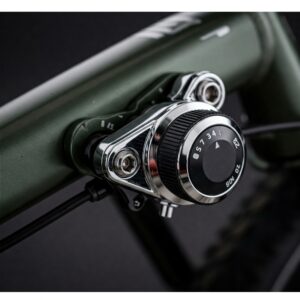
Conclusion
E bike suspension technology continues to evolve alongside the rapidly growing electric bicycle market. As e bikes become more specialized for different applications, suspension systems are being tailored to meet these specific needs, resulting in better performance, comfort, and durability.
Whether you’re a daily commuter looking for basic comfort improvements or an adventurous trail rider seeking maximum performance, there’s an e bike suspension solution that will match your requirements. By understanding the fundamentals of suspension design, setup, and maintenance, you can make informed decisions that will significantly enhance your riding experience.
Remember that the best suspension setup is one that you barely notice – it should simply make the bike feel natural and controlled, allowing you to focus on enjoying the ride rather than fighting the terrain. With the right components, properly set up and maintained, your e bike can provide thousands of miles of comfortable, confident riding on any surface.
More FAQs
❓ How much travel does an e bike suspension typically have?
✅ E bike suspension typically offers 80-200mm of travel... Front suspension for urban e bikes usually has 80-120mm, while e mountain bikes feature 130-170mm front and 130-160mm rear travel. The optimal amount depends on your riding style and terrain...
❓ Are suspension forks for e bikes different from regular bikes?
✅ Yes, e bike suspension forks are specifically reinforced to handle additional weight and forces... They feature stronger chassis, e-bike specific damping tunes, and often come with torque arm compatibility. Standard bicycle forks may fail prematurely when used on e bikes...
❓ How often should I service my e bike suspension?
✅ E bike suspension typically requires basic service every 50 hours and full service every 100-200 hours... Due to increased weight and forces, service intervals may be shorter than on traditional bikes. Light service includes cleaning and regreasing seals, while full service replaces oil and internal components...
❓ What's the price range for quality e bike suspension upgrades?
✅ Quality e bike suspension upgrades range from $150-1,500 depending on component and performance level... Entry-level suspension seatposts start around $150, mid-range front forks cost $300-700, and premium full suspension components can exceed $1,200. Higher-priced options offer better damping, adjustability, and durability...
❓ Can I install e bike suspension components myself?
✅ Basic components like suspension seatposts can be installed by most riders with basic tools... However, fork and shock installation often requires specialized tools and knowledge of headset standards, torque specifications, and brake mounting. Professional installation is recommended for critical suspension components to ensure safety and performance...
Recommended for You:
- 10 Essential Ebike Wheel Facts Every Smart Rider Should Know in 2025
- 10 Best E Bike Thumb Throttle Options For Maximum Control in 2025
- 10 Revolutionary Electric Bike Frame Designs That Transform Your Riding Experience in 2025
Disclaimer: This article contains affiliate links. If you purchase products through these links, we may earn a small commission at no additional cost to you.
✨ Found this helpful? Share it with your friends! 💬🤗
